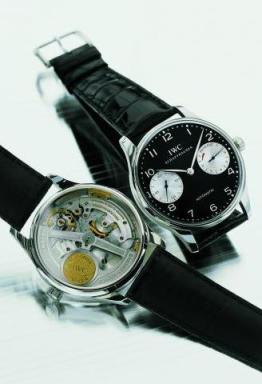| |
OPENING COMMENTS
The Hunt
JL: My quest for the "Supreme watch" began several months ago. I was in search of a high-end piece to add to my collection, something dressy yet sporty, that was also of horological significance. One of my all time favorites is the IWC 1993 Portuguese Jubilee. A masterpiece in its own right, the 1993 Jubilee fits all my criteria, but unfortunately the lucky few who covet these babies know the rarity of this watch. As I found out, I would have had a better chance of discovering the secret of the Pyramids before locating a Jubilee Portuguese for sale, they are truly next to IMPOSSIBLE to obtain! Hence my dreams of owning a big Portuguese were crushed. Or were they? News from Basel 2000 revealed that I could very well have the opportunity to obtain a Portuguese...from the next generation! IWC's latest creation The Portuguese 2000 which will contain IWC's latest in-house movement, the Calibre 5000, featuring a patented Pellaton winding system was in production!
I was desperate to find out more details on this watch and thanks to the TimeZone IWC forum, the information was soon flowing. Like the 1993 Jubilee, the Calibre 5000 Portuguese will be a limited edition watch. Available in a three-piece box set of platinum, rose gold and steel (U.S. Retail Price $45,000) as well as in individual pieces in steel (U.S. $10,500), rose gold (U.S. $15,000) and in platinum (U.S. $19,000). Production for the Calibre 5000 Portuguese is strictly limited to 2000 pieces TOTAL, hence the name: Portuguese 2000. The first pieces 100 of each watch in Steel, Rose Gold & Platinum are reserved for the box sets, and each watch within a set will share the same edition number. With no definite release date in sight all I could do is keep my eyes and ears open and wait for them to hit the showcases of USA dealers.
MS: Those of you who know Jon understand the full extent of his obsession. Once he decides that he wants a watch, there is absolutely nothing that I am aware of that can divert him from that goal. Those of you who have actually seen him realize that the laws of physics would seem to indicate that diverting Jon would require a tremendous counteracting force. In short...if he wants it, get out of the way!
First Sightings
JL: A fellow TimeZoner posted on the IWC forum that he had spotted the Cal. 5000 at a dealer in NYC. A few days later Michael Sandler and I are sitting in WEMPE with the Cal 5000 in our sweaty hands. Needless to say my first encounter with the cal 5000 left me with one impression…I MUST HAVE ONE!!
MS: When I walked into the store, I knew that Jon was going to end up with the watch. The half gallon of drool he left on the window of the IWC display was pretty much a dead giveaway. Neither of our opinions changed much after actually handling the watch. It makes a very good first impression.
The "Deal"
JL: OK, so now I'm dead set on getting a Cal. 5000, but how? My 10,000 phone calls and e-mail inquires across the planet have turned up nothing. Dealers are taking names but not making promises….NOT GOOD, so what to do? Do I chance waiting for one to pop up on the TZ Sales Corner? I received an email from a fellow TZer who posed the question "why not form a syndicate and go for the box set?" Great idea! But just how easy is it going to be to try and find two fellows who are more insane than I and looking for one Cal. 5000 in platinum and one in rose gold? Within several days of my inquiry on the IWC forum I had found my comrades (LUDWIG & STEVEN...thanks again guys!). I Had already located a Cal. 5000 box set and negotiated the price with the seller. We were ready to rock and roll! Within the next week I would have received a package from Switzerland that contained the Flagship of my collection.
MS: Jon's resourcefulness when it comes to the acquisition of a new watch rarely surprises me. The fact that he was able to arrange a group purchase of the set is not a surprise at all. What was surprising is the speed at which it all came together. Pretty impressive. I'm fairly sure Jon would have done just about anything to get his hands on the watch, and I'm just glad nobody was physically injured in the process. I hope the other two purchasers are just as happy with their watches.
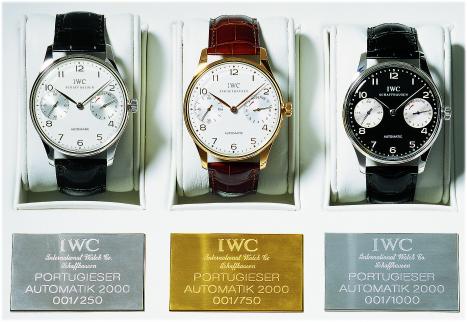
A LITTLE HISTORICAL PERSPECTIVE
MS: The original Portuguese wristwatch was conceived in 1938, following a request from two Portuguese businessmen, Rodriguez and Texeira. .They wanted IWC to construct a highly accurate, oversized wristwatch. At the time, wristwatches were quite small by today's standards, case diameters were usually below 33 millimeters in diameter. The requested watch was to be substantially larger. To power this unusual piece, IWC's watchmakers selected the Calibre 74, a hunter-style pocketwatch movement. During the 1940's, IWC sold a relatively small number of other oversized Portuguese watches, but never quite enough to justify large scale production of the pieces. Click on the thumbnail below to see a full size image of three of the original Portuguese watches.
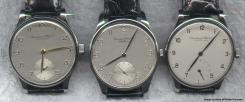
In 1993, to celebrate the 125th anniversary of the company, they again released the Portuguese, this time named the Jubilee. The Jubilee was produced as a limited edition, available in cases of platinum, gold, and steel. Demand was strong, and the edition sold out quickly. Since the re-introduction of the Portuguese was met with enthusiasm, the company has subsequently released a number of other variants, including a minute repeater, a chronograph, and a split-second chronograph. A smaller (approximately 35 millimeter diameter) Portuguese is also available as a standard model in the IWC line. The thumbnails below link to images of the 1993 Jubilee Portuguese.
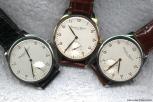  
For more detailed information, an excellent article on IWC's Pocket/Wrist Watches by Michael Friedberg and foie gras can be found here.
Additionally, Richard Paige's terrific pictorial on his IWC Portuguese Jubilee can be found here.
THE REVIEW
Crystal, Dial and Hands
JL: The acrylic crystal sits 4 millimeters high on the watch (see picture on left below). At first, I was miffed at the thought of a plastic crystal on such an exclusive (and expensive) watch but, it does follow in the tradition of the Portuguese and I feel that it adds class and character to the watch. The black dial has a semi-gloss finish with silver embossed Arabic numerals and minute indicators. The sub-dials (constant seconds at 9, and power reserve at 3) are also silver in color. Blued hands are used on both sub-dials. The hour and minute hands are the large classic Portuguese silver swallow-style hands. I find this dial to be one of the cleanest and most perfect layouts I have ever seen on a watch.
MS: When Jon first found out the watch had an acrylic crystal, I had to talk him off a ledge he was so upset. In the long run, though, I think the historic significance of a plastic crystal makes it an appropriate choice. Although less durable than sapphire, minor scuffs and scratches can be removed with relative ease when compared to the much harder sapphire. Additionally, producing a sapphire crystal with the steep edge seen on this crystal would seem to be a difficult proposition, although this is merely a hunch. The dial is terrific, and very legible. I can't say the same of the rhodium plated hands, though. Due to their high polish, they seem to disappear in certain lighting conditions, making discerning the time a chore. This can be seen in the picture on the right below. The numerals are embossed, just like the original Portuguese and the Jubilee edition of 1993. In this model, they are plated with rhodium to match the hands.
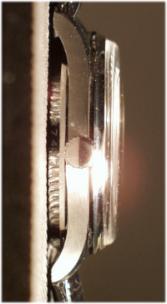 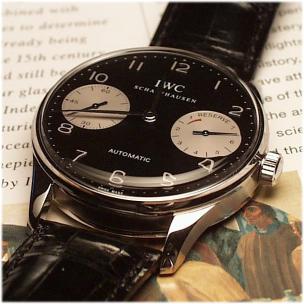
Case
JL: The case is 42mm. X 14mm. (including crystal) and according to IWC the original case used for the first Portuguese watches and the limited edition 1993 Jubilee. The Cal.5000's is case is slightly thicker due to the added height of the display back. The bezel, top of the lugs and crown are luxuriously polished to a gleaming finish. The sides of the case are done with fine satin finish.
The left side of the case reveals the engraved limited edition serial number (64/1000).
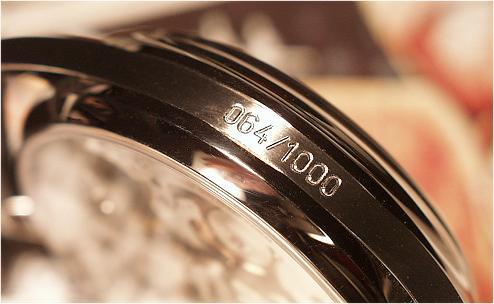
One of the first things I noticed was that there was NO little IWC fishy on the crown (see image below), which means NO WATER RESISTANCE! I was somewhat concerned at the fact that a watch at this price point would have no water resistance so I inquired to IWC Switzerland about this and they reassuringly replied:
| "Nevertheless, the case is fitted out with all the necessities for the water resistance. During the finish control, the watch is also checked for the water resistance. The specification "not water resistant" is just for water sports, the daily load isn't a problem for your watch." |
Granted, I don't ever intend to use this watch in or around water but I was concerned about humidity and moisture.
MS: The case styling of this watch is traditionally simple, with no superfluous design elements. It is completely consistent with the clean, functional look of the rest of the watch. The rim of the display back and the bezel/front of the case are polished to a shine, while the sides of the case are lightly brushed. This creates a nice contrast, and "tones down" the case a little. I like this approach on the Lange cases, and I like it with the Portuguese as well.
At first glance, it actually seems larger than 42mm in diameter, due to its relatively narrow bezel. Looking at the dial straight-on, almost the entire front of the watch is taken up by the dial. The watch itself is nice and heavy, and feels very substantial. Although it is comparably large, it sits quite comfortably, even on my small (slightly less than 7 inches in circumference) wrist. Due to its size, though, wearing the watch under shirts with tight cuffs is problematic.
The crown is appropriately sized, and easy to grip. Winding is smooth and stiff. Directly beneath the crown on the periphery of the caseback is a seven digit serial number, uniquely identifying the watch.
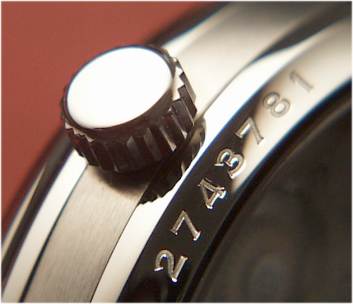
Caseback/Movement
JL: Flip this baby over and the fun begins. The huge sapphire glass back reveals the amazing 5000 calibre in all its glory. The massive rotor with its beautiful gold IWC Probus Scafusia medallion embedded into the middle is a just a marvel to gaze at. If it was possible, I would wear this watch back side up! Pictures do no justice! To truly appreciate the beauty of this watch, it must be physically seen and held to believe.
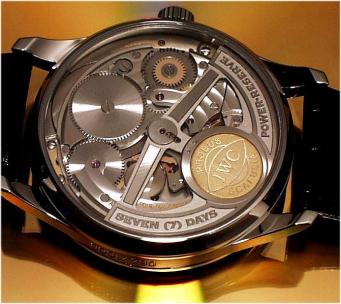
MS: The first thing everyone seems to notice when looking at the movement is the rotor. The dull gray of the rotor is contrasted by the gold in the medallion mounted in its center. The words "SEVEN (7) DAYS" and "POWER-RESERVE" in very heavy raised lettering are present along the outer edge of the rotor. The gold medallion in the center contains"PROBUS SCAFUSIA", along with a large "IWC" in the center. The plates of the movement are very well finished, but are definitely not as "pretty" as something from Patek or Audemars. Consistent with IWC's conservative approach, the movement plates contain what could probably be called Cotes de Geneve, or I suppose more appropriately, Cotes de Schaffhausen. Even under scrutiny with a 10 power loupe, the edges of the plates and wheels are immaculate, and no rough edges are obvious. I am not really qualified to comment on more technical aspects of the movement's design, so I will leave that to the experts.
This movement is IWC's largest automatic, featuring a power reserve display, hour, minute and small seconds hands. Although the movement has a power reserve of 204 hours (8.5 days), it stops automatically after 168 hours or seven days if not wound. Development of the Calibre 5000 by IWC took approximately four years.
The movement consists of 286 parts, 178 of which are different. Fourty-four (44) jewels are used. It is 38.2 millimeters in diameter and 7.2 millimeters thick. By contrast, the ETA Calibre 2892 is 25.6 millimeters in diameter and 3.6 millimeters thick, and the Valjoux Calibre 7750 chronograph movement is 30 millimeters in diameter and 7.9 millimeters thick.
The two spoke balance has 16 screw weights and two adjusting cams. The entire escapement is very similar to that found in another of IWC's renowned movements, the hand-wound 89 calibre movement used in the Mark XI and numerous other IWC models. A Breguet overcoil is used. They also mean that the escapement beats at 18,000 alternations per hour, as did many of the pocket-watches after which this movement was patterned. In theory, the slower beat should translate into less overall wear and tear on the movement, although it could also leave the movement more susceptible to beat errors for which a faster beat movement may compensate more effectively.
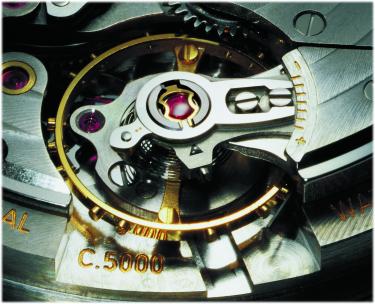
Strap and Buckle
JL: Absolutely NOT to my liking, the strap (22mm at the lugs and 18mm at the buckle) is a super high gloss black crocodile with the standard steel IWC tang buckle. I have since ordered a black matte finish full cut croco strap with IWC deployant, which I feel will compliment the looks of the watch much better than the supplied strap and buckle.
MS: I agree completely with Jon's assessment of the strap. Although it may be of high quality, it's simply too shiny for this watch. The overall design of the watch is relatively understated (well, except for its size), and the glossy strap is too flashy. A matte, padded strap would be much more suitable. Additionally, the stock strap seemed to crease very easily. Nothing much needs to be said about the buckle, since it's basically identical to the one found on several other watches in the IWC line, including the Fliegerchronograph and the Doppelchronograph. My personal preference would be to keep the tang buckle rather than switching to the deployant. I think the simple tang buckle is more consistent with the "historic" feel of the watch. A picture of the stock strap and buckle is below.
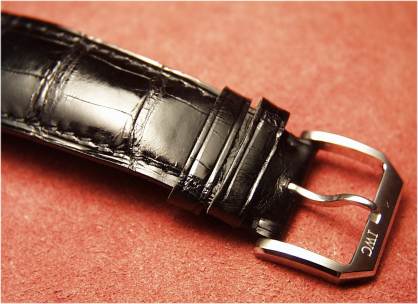
Accuracy
JL: Outstanding! On my Scatola winder the Cal. 5000 is humming along at +3 seconds per 24 hours. Off the winder and sitting in my watch box with the dial up, it has been DEAD ON (zero gain/loss) for over 3 days.
MS: I'd expect nothing less than excellent performance from a watch at this price point, and Jon's results indicate that performance is as expected. Interestingly, does anyone else find it curious that Jon makes no mention of "on the wrist" performance? Wear the watch, Jon...wear the watch!!
THE SPECIFICATIONS
| Case Composition: | | Stainless steel (also available in 18K gold and platinum) |
| Case Diameter: | | 42 millimeters |
| Case Height: | | 14 millimeters, including crystal |
| Crystal Height: | | 4 millimeters |
| Distance Between Lugs: | | 22 millimeters |
| Buckle Size: | | 18 millimeters |
| Movement Diameter: | | 38.2 millimeters (IWC's largest automatic movement) |
| Movement Height: | | 7.2 millimeters |
| Balance: | | Chronometer quality Nivarox 1 balance spring with Breguet overcoil; 18,000 beats per hour |
| Winding: | | Bi-directional |
| Power Reserve: | | 8.5 days; however movement stops automatically after 168 hours (7 days), to assure timekeeping precision, if not wound. |
| Parts: | | Total of 286 parts, including 35 sub-assemblies, 12 bridges, 53 differently shaped wheels, 44 jewels |
| Shock Resistance: | | Incabloc system |
| Edition Size: | | Steel: 1,000; Gold: 750; Platinum: 250 |
THE IMAGES
Click on the thumbnail to load the full-size image.
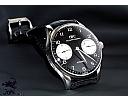 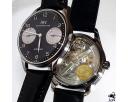 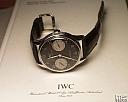 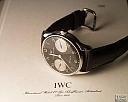 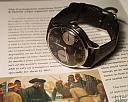 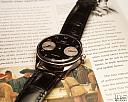 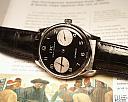 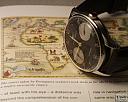 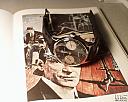 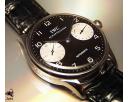 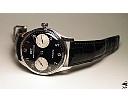 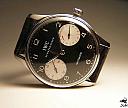 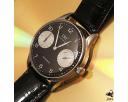 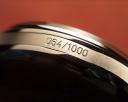 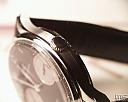 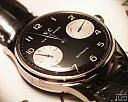 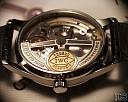 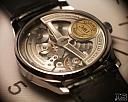 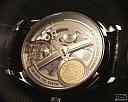 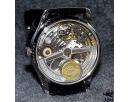 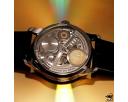 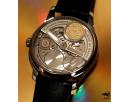 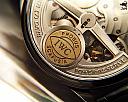 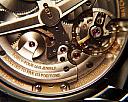 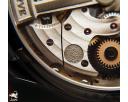
Credits:
MK11/Roland Kammer for the images of the original Portuguese watches and the Jubilee Portuguese
Michael Friedberg for information on the history of the Portuguese model
Bill Deschler, Kristie & Chrissy at IWC (USA) service for information on the case and crystal
Veronika Michel at IWC (Switzerland) for information on the watch hands and dial
Other data, including the first three images and the balance wheel image gathered from IWC press releases, catalog and website at http://www.iwc.ch.
Copyright © 2000, Jon Lombardi and Michael Sandler
All Rights Reserved
|
|
|































